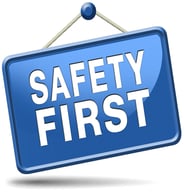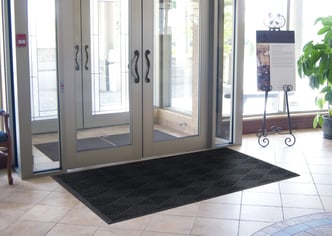Floor mats are an essential part of a facility safety program. When selected correctly, they can help keep outdoor moisture and soils from being tracked onto indoor floors, potentially causing slip, trip and fall accidents.
 When surveying our customers, the most frequent concern was “How do I know if I have the right mat?”
When surveying our customers, the most frequent concern was “How do I know if I have the right mat?”
Floor mats must be selected, installed, and maintained properly to help ensure they do their job and help prevent accidents. To accomplish this, here are some things facility managers should know:

Outside entries. Outdoor entry mats should be positioned so that they touch the edge of the entry door opening. There should not be a gap, exposing a portion of the outside walkway to the walker's shoe bottom.
Molded edges. Mats with molded or beveled edges ensure that the walker makes a smooth transition from walking over a hard-surface floor onto the mat. Molded edges also can help prevent mats from curling at corners, another factor which could cause a trip or fall.
Rental mats. In general, rental mats are thin and made of lower-quality fibers and materials. The problem here is that if the mat is used, for instance, to absorb moisture and help clean the walker's shoe bottoms, its effectiveness is not only limited from the start, but during the day, the mat quickly becomes saturated with moisture and contaminants. When this happens, instead of being absorbed, moisture and soils can reattach to shoe bottoms, defeating the entire purpose of an entry mat.
Weight. Mats require sufficient heft to adhere securely to a building entry or a building floor, but thin mats may not weigh enough to do so. Instead, thin mats lose their stability, curl, fold, and become a slip-and-fall hazard. To prevent this, the weight of the mat should reflect the amount of foot traffic it receives. If there is very little foot traffic, a thin, light mat may suffice. However, in most situations, a heavier, more stable matting system will enhance building safety.
Size. Mats are often five feet long. However, one five-foot long mat is not sufficient. In most cases, what facility managers should consider is referred to as the "Rule of 15." Install five feet of matting outside a facility; another five feet in a vestibule door area or directly inside the facility; and five more feet of matting beyond this. When the right mats are selected, the Rule of 15 makes it possible that as much as 70 percent of the moisture and soils on a walker's shoe bottoms are removed by the time, they step on to the facility's floor covering.
Cleaning. Mats should be vacuumed through the course of the day based on climate conditions and foot traffic. They also should be spotted when spots are noticeable and cleaned.
Storage. While it is often a good idea to roll rugs up when they are not in use, this is not true of mats. After cleaning or when in storage, mats should always be stored flat, face up to prevent distortion and ensure that the mat will remain safe and hazard free .
For more information on mats, contact our Customer Service Sales Team.
Comments